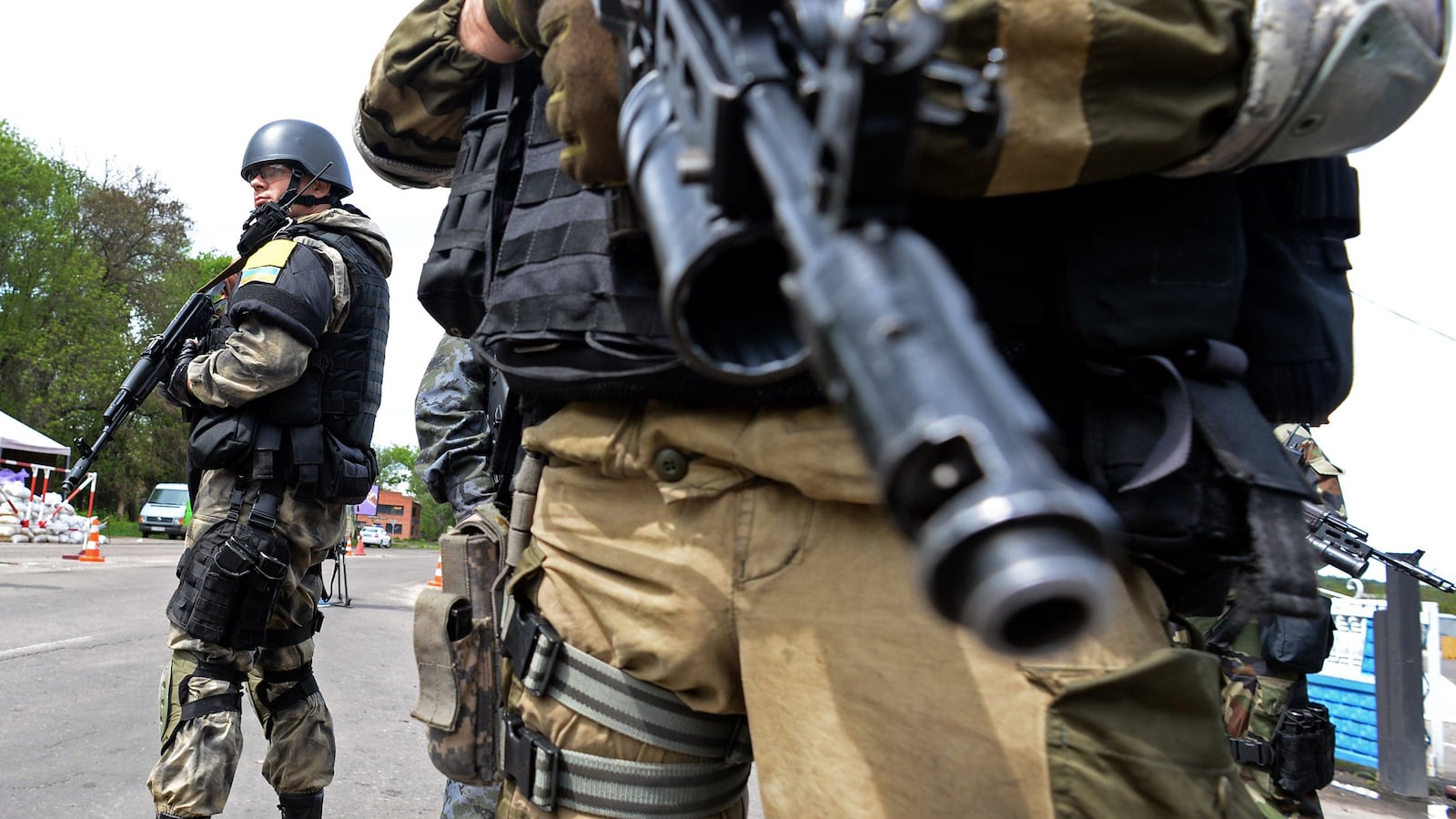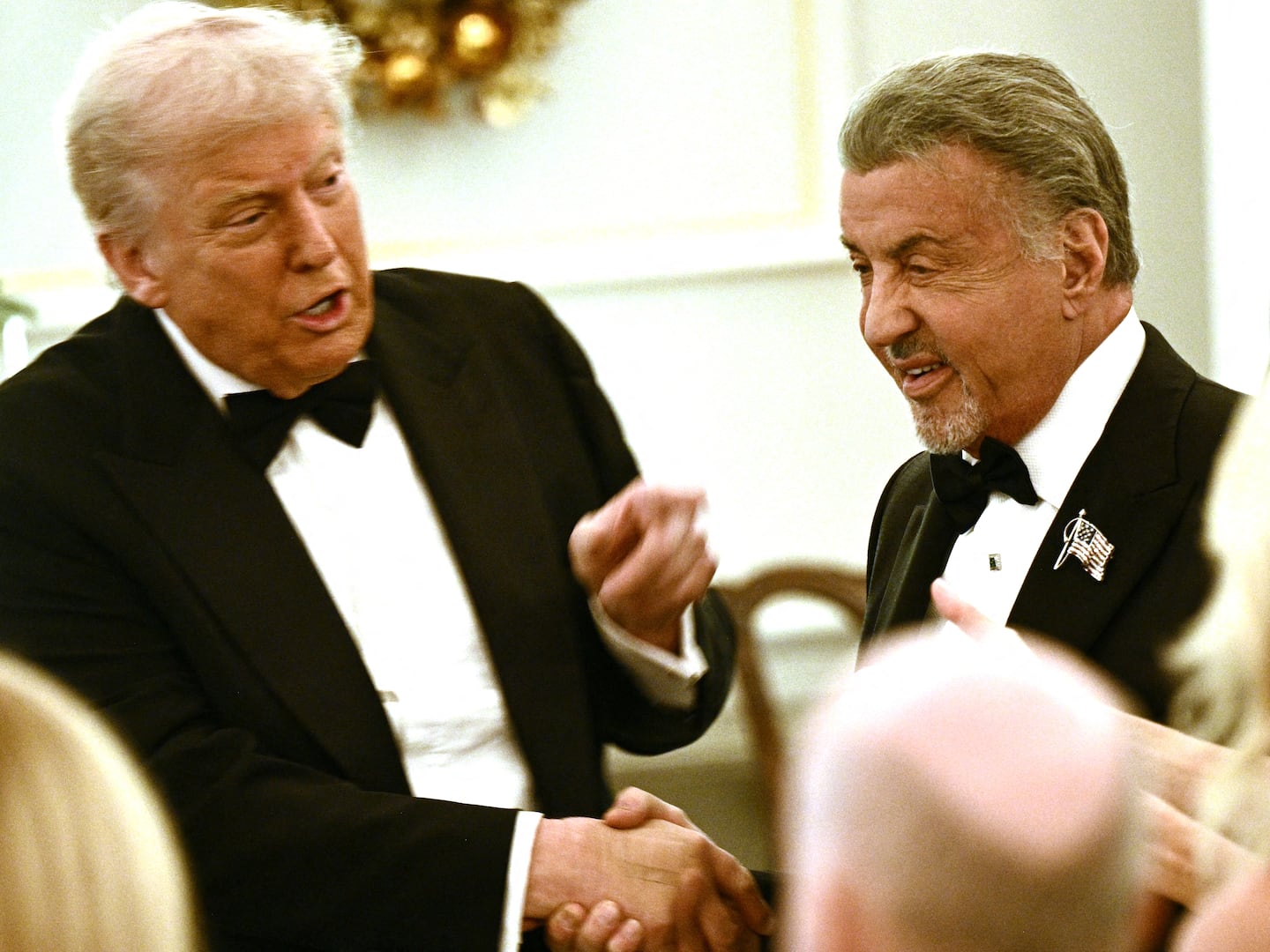SLOVYANSK, Ukraine — The doctor at the psychiatric hospital didn’t miss a beat. As we left the 400-patient facility on the outskirts of the separatist-controlled town of Slovyansk he wished a colleague and me well, adding, “Be careful, there are a lot of crazy people out there.”

That warning was borne out quickly with paranoid locals outside the gates of the hospital insisting the British army had taken to the field and that British soldiers are now helping the Ukrainian military in its fight against pro-Russian militants.
Two hundred meters down the road a tractor-trailer was still smoldering after sending plumes of acrid black smoke swirling across a junction in the small village of Semenovka. The vehicle had been hit in the crossfire of a two-hour battle between Ukrainian anti-terrorist units and pro-Russian separatists and the body of the young driver, covered by a yellow tarpaulin, was still lying in front of a roadside café.
“We don’t know who he is,” said 24-year-old secretary Nadin, who spoke with us on condition that we not publish her last name. “We can’t tell his family that he is dead,” she lamented.
As far as Nadin and her family are concerned, the crazy people had paid them a visit—and the crazies, in their view, are not the separatists. Theirs is a middle-class family—her father runs an advertising agency—and they, too, were caught in the midst of the firefight as bullets riddled their house, shattering windows and tearing up the siding.
Fortunately there was only one casualty at Nadin’s home: the pet parrot was pretty much obliterated by an AK47 round.
“I think after this shooting a lot of people will be afraid of our government and I think they will ask for help from Russia,” said Nadin. Her 70-year-old grandmother was in shock and kept repeating obsessively: “We had all this shooting without any warning. They should have warned us. They didn’t say anything to us.”
Six people died in the firefight—one a Ukrainian soldier—and there were seven critically wounded, according to the psychiatrists, who were pressed into service as triage doctors. Government officials say yesterday’s skirmish at Semenovka on the north side of Slovyansk was a success: Units loyal to the government in Kiev had driven away some armed separatists who had taken up positions in the gardens of the houses at the junction.
But Nadin’s grandmother makes a valid counter-insurgency point when she asks over a cup of coffee why the Ukrainian forces shot up the place and then withdrew. “Why didn’t they stay?” she asks.
And that in a nutshell is what is questionable about the whole thrust of Kiev’s “anti-terrorist operation” in eastern Ukraine, which was resumed on Friday, two days after acting President Oleksandr Turchynov announced that the Ukrainian security forces had lost control of this industrial region with a population of more than 6 million abutting the Russian border.
The Ukrainian counter-insurgency operation seems to rely on hit-and-run tactics that aren’t denying much territory to the separatists but are inflaming local opinion and losing the battle for hearts and minds. The operation isn’t stabilizing the region or helping to stem the rising lawlessness—something most people across the east are desperate to see brought to an end. In a sign of the lack of confidence in Kiev’s ability to restore law and order, two of the country’s largest banks, Privatbank and Raiffeisen Bank Aval, have temporarily closed their branches in Ukraine’s eastern Donetsk and Luhansk regions, saying that they can’t guarantee staff safety.
The relaunched anti-terrorist operation is focused on Slovyansk, which has become the poster town for the pro-Russian insurgency, and its larger neighbor Kramatorsk. Slovyansk serves as the main base for the militancy across the region. The strategy of the Ukrainian forces has been to surround and isolate the separatists, reduce the space in which they can operate, and drive them to retreat to the government buildings they seized in both towns.
The Kiev government claims it is making progress in this military struggle, although officials admit their forces still have to advance on the center of Slovyansk.
Over the weekend, Kiev forces captured a TV tower on a hill overlooking Slovyansk and successfully defended it from a separatist attack on Monday. According to Ukraine’s interior minister, Arsen Avakov, government forces have Slovyansk encircled and the noose is being tightened.
As far as Kramatorsk is concerned, in the eyes of Kiev, at least, things are also going swimmingly. Ukrainian Security Services spokeswoman Maryna Ostapenko says the operation is advancing as planned. “Now I can say that Kramatorsk is under the control of the anti-terrorist forces,” she told reporters in Kiev. For these territorial gains over four days the costs have been high: Kiev forces have lost three military helicopters, a half-dozen soldiers have been killed and more than 100 wounded, according to the government’s tally.
But the picture painted by Kiev officials doesn’t match the reality on the ground—and it is unclear whether officials are delusional or just think this is the way to win the information war.
Some analysts in Kiev, like Dmitry Tymchuk of the Center for Military and Political Research, are not convinced by the government’s version. “If they have blocked Slovyansk, I question how tight it is blocked and how effective this area is controlled now,” he told reporters. “With other areas—for example, Kramatorsk in particular—I have huge questions.”
Tymchuk is right to be skeptical, and The Daily Beast, which toured (gingerly) around Slovyansk, can answer some of his questions. The blockade is not tight. Separatist checkpoints around the town were cleared one day by Kiev forces and returned the next.
On the road to Kramatorsk traffic is being filtered effectively by Ukrainian airborne troops and separatist checkpoints directly south have had to relocate a few hundred meters nearer the besieged town. Government forces to the north along the road to Izium are effectively controlling traffic movement. But all other directions are wide open and you have to travel more than 20 kilometers southeast before you run across an army checkpoint.
On many side roads and dirt tracks through the woods surrounding the town of 130,000 there is no military presence. Separatist fighters are still finding it relatively easy moving in and out of Slovyansk: A new separatist commander for pro-Russian militants in the neighboring town of Kostiantynivka was dispatched Monday from Slovyansk and traveled with ease to take up his command.
And the facts on the ground in Kramatorsk also bear no resemblance to what is being claimed in Kiev by government officials.
During the weekend the country’s interior ministry announced Kiev forces had recaptured Kramatorsk’s central police station. But Monday, when The Daily Beast visited, the desk sergeant laughed and said there are now two police chiefs—the official acting chief, or the separatist Donetsk Republic’s chief. On the streets of the city there was no sign of any Ukrainian military personnel. And surprisingly, at 4 a.m. on Monday Ukrainian Special Forces units withdrew all their forces from Kramatorsk’s small civilian airport, a forward base they had struggled to defend from sporadic separatist attacks.
Separatists interpret the airport withdrawal as a victory. Some military analysts suspect the Special Forces units were shifted to Slovyansk because Kiev doesn’t have enough troops to rely on and is spread thin.
The lack of progress in the towns north of Donetsk raises questions about the ability of Ukrainian security forces to confront the broader uprising that Kiev says is fomented and directed by Moscow—an accusation the Kremlin denies.
To the northeast in the town of Luhansk, Kiev is facing further challenges. It managed to evict armed separatists from one government building—they were allowed to leave with their weapons—but the separatist leader in the town, Valeriy Bolotov, has declared a state of emergency and announced the formation of a “South-East Army.” He has declared a curfew, a ban on political parties, and has ordered local law enforcement officials to take an oath of allegiance to the people of Luhansk.
In a further ominous move that Kiev just doesn’t have the forces to counter, armed separatists have started to block border checkpoints, prompting some military analysts to speculate that they have been instructed to do so by Moscow.
As the local psychiatrists attest, the situation grows crazier by the day.






